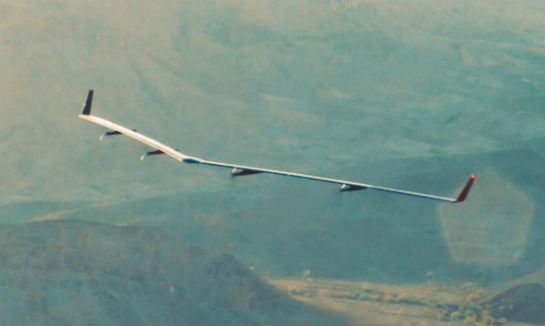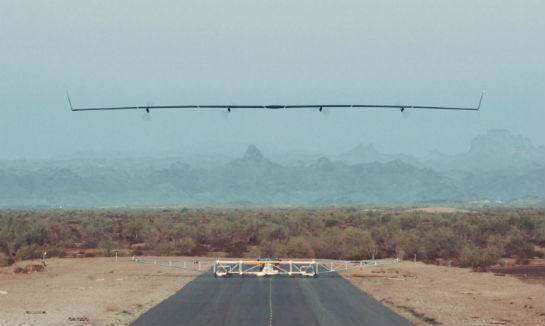Estimated reading time 5 minutes, 8 seconds.
Facebook’s Aquila plane, an unmanned solar aircraft aimed at providing Internet access to remote areas, recently completed its first flight. Facebook Photo
At sunrise on the morning of June 28, 2016, an unmanned plane with a wingspan larger than a Boeing 737 launched down a narrow runway and into the skies over Yuma, Ariz.
It flew for 96 minutes, more than three times longer than expected, and marked an important milestone in a program aimed at providing Internet access to people in remote regions with no access to a mobile broadband network.
This was the first full-scale test flight of Aquila, a solar-powered plane Facebook is developing as part of its efforts to bring Internet connectivity to billions of people around the world who are not yet online.
It’s expected Aquila will be able to circle a region up to 60 miles in diameter, beaming connectivity down using laser communications and millimetre wave systems.
“Eventually, our goal is to have a fleet of Aquilas flying together at 60,000 feet, communicating with each other with lasers and staying aloft for months at a time—something that’s never been done before,” said Facebook founder and CEO Mark Zuckerberg in a post on the social media site.
Aquila’s body is made of a carbon fibre composite and weighs less than 1,000 pounds—about the same as a grand piano, said Zuckerberg.
“We need to continue to make it lighter,” he added.
At cruising altitude, Aquila uses about 5,000 watts of power, about as much as three hairdryers or a high-end microwave.
“We’re always looking for ways to trim this down and make our systems more efficient,” said Zuckerberg.
Aquila relies on a ground crew of about a dozen engineers, pilots and technicians and flies slowly—often at less than 130 kilometres per hour—to save energy and maximize endurance.
Aquila’s body is made of a carbon fibre composite and weighs less than 1,000 pounds—about the same as a grand piano. Facebook Photo
Almost half of Aquila’s mass will come from high-energy batteries, said Zuckerberg.
“That’s a lot of weight to put on large, flexible wings, which is why we have computer models to predict how Aquila’s shape deforms under load,” he said. “A few more flights will help us better understand the actual in-flight dynamics.”
To reach its goal of flying for months at a time, Aquila will need to break the world record for solar-powered unmanned flight, which stands at two weeks.
Facebook intends to push Aquila to its limits in a series of tests in the coming months and years, the company said in a news release.
“As we conduct more test flights, we will add more aircraft to the test fleet, fly to higher altitudes, and explore both the high-speed regime—where the airframe’s flexibility becomes limiting—and the low-speed loiter regime, where the aircraft will eventually provide connectivity to the ground,” added project engineers Martin Luis Gomez and Andrew Cox in a joint blog post.
“We will add instrumentation to the aircraft to help us learn about the structural dynamics, stability and control derivatives, and the all-important aerodynamic efficiency. We’ll also experiment with different aircraft form factors, sizes, and weights as we learn more.”
According to Facebook, 1.6 billion people live in remote locations with no access to mobile broadband networks. Aquila is part of a larger strategy to bring Internet connectivity to the four billion people around the world who are not online.
The company estimates its connectivity efforts to date have brought more than 25 million people online who wouldn’t be otherwise.
Watch a video of Aquila in action
here.



